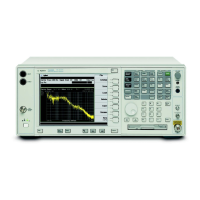Chapter 4 205
Instrument Functions: P - Z
Peak Search
Instrument Functions: P - Z
4.1.3 Next Pk Left
Moves the marker to the next peak to the left of the current marker. The peak must meet
the defined peak excursion and threshold limits. Peaks that are less than 1% of the current
span away from 0 Hz are ignored. If no valid peak is found, an error “
No Peak Found” is
displayed. Press
ESC to clear this message before attempting another search. (Also see the
Peak Excursn and Pk Threshold key descriptions.)
Key Path:
Peak Search
State Saved: Not part of saved state.
Remote Command:
:CALCulate:MARKer[1]|2|3|4:MAXimum:LEFT
Example: CALC:MARK2:MAX:LEFT selects marker 2 and moves it to the next peak to
the left.
4.1.4 Min Search
Moves the active marker to the minimum detected amplitude value on the current trace.
Key Path:
Peak Search
State Saved: Not part of saved state.
Remote Command:
:CALCulate:MARKer[1]|2|3|4:MINimum
Example: CALC:MARK:MIN selects marker 1 and moves it to the minimum amplitude
value.
4.1.5 Pk-Pk Search
Finds and displays the amplitude and frequency (or time, if in zero span) differences
between the highest and lowest trace points by setting a reference marker on the peak
signal and placing a
∆ marker on the minimum signal.
Key Path:
Peak Search
State Saved: Not part of saved state.
Remote Command:
:CALCulate:MARKer[1]|2|3|4:PTPeak
Example: CALC:MARK:PTP
CALC:MARK:Y? queries the delta amplitude value for marker 1. For more
information on this command, see “Marker” on page 167.

